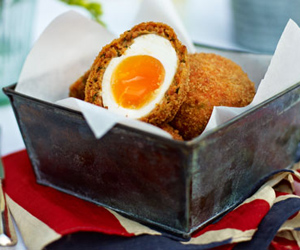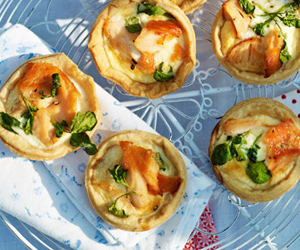
And Tesco have said that Anna's recipes are "fit for a Queen". Here are a few of them to conjure up the spirit of the Jubilee celebrations!


Chorizo Scotch Eggs
Ingredients
- 4 tbsp flat-leaf parsley
- 1 x 200g pack chorizo cooking sausages, skins removed
- 1 x 200g pack pork sausages, skins removed
- ½ tsp hot paprika
- 100g (3½oz) plain flour
- 100g (3½oz) breadcrumbs
- sunflower oil, enough for deep frying
How to make Chorizo Scotch Eggs
Put 6 of the eggs in a pan of boiling water. Bring back to the boil and simmer the eggs for 7 minutes for a firm set yolk. Remove the boiled eggs from the pan with a slotted spoon and plunge into a bowl of iced water to cool, then carefully peel off the shell.
Meanwhile, put the parsley in a food processor and pulse until chopped. Add the chorizo, sausage meat and paprika, a little salt and lots of freshly ground black pepper and whizz until combined (if the mixture looks a little thick, add 1 tbsp of cold water), then divide into 6 balls. Flatten the balls into large discs and place each one on a small piece of clingfilm.
Dust the boiled eggs with a little flour and then wrap the sausage meat around each egg, using the clingfilm to help you. Make sure they are well sealed. Chill for 20 minutes to firm up.
Preheat the oven to gas 5, 190°C, fan 170°C. Put the remaining flour and the breadcrumbs on two separate plates and season well, then crack the remaining raw egg into a shallow dish and beat lightly. Dip the sausage coated eggs in the flour, followed by the egg and then the breadcrumbs. Repeat until all the eggs are coated.
Fill a large saucepan roughly halfway with sunflower oil (enough to just cover the eggs) and heat to 190°C using a kitchen thermometer. If you don’t have a thermometer, you can test the temperature by dropping a cube of bread into the oil. If it turns golden in 30 seconds, it means the oil is hot enough for the eggs. Using a slotted spoon, lower the eggs into the oil two at a time and fry for 2-3 minutes, until golden. Remove with the slotted spoon, drain on kitchen paper and then put on a baking tray. Repeat with the rest of the eggs.
Bake the eggs for 10 minutes, until golden. Remove from the oven and leave to cool for 2-3 minutes. To serve, slice in half and serve warm, if you like, or at room temperature.
745 calories; 2g sugar; 62g fat; 13.9g saturates;
2.4g salt

Salmon and Horseradish
Tartlets
Ingredients
- flour, for dusting
- 375g ready-rolled shortcrust pastry
- 100ml (3½fl oz) double cream
- 1 large egg, beaten
- 2tsp horseradish sauce
- 100g (3½oz) smoked salmon fillet, cooked
- flaked handful of watercress
How to make Salmon and Horseradish Tartlets
Preheat the oven to gas 6, 200°C, fan 180°C. Lightly flour a clean surface and roll out the pastry thinly. Using an 8cm fluted cutter, stamp out 12 rounds and press into a greased 12-hole bun tin. Prick each base with a fork and chill for 10 minutes.
Line each pastry case with a small piece of kitchen foil (allow a slight overhang to help you remove it later) and fill with baking beans. Blind bake in the oven for 10 minutes, until the pastry is just turning golden and firm to the touch. Remove the foil and baking beans, then return to the oven for a further 3 minutes, until golden and crisp. Turn down the oven to gas 4, 1380°C, fan 160°C.
Beat together the cream, egg and horseradish with a little salt and fresh black pepper in a jug. Divide the flaked salmon between the pastry cases and tuck in a few sprigs of watercress around the flakes. Carefully pour in the egg mixture around the salmon and watercress, until just full.
Bake in the oven for 12-15 minutes, until the filling has just set. To serve, remove from the tin and enjoy warm or allow to cool.
140 calories; 1g sugar; 6g fat; 5g saturates;
0.4g salt

Chocolate Melting Moments
Ingredients
- 175g (6oz) slightly salted butter, softened
- 60g (2½oz) icing sugar, sifted
- 1tsp vanilla extract
- 150g (5oz) plain flour, sifted
- 60g (2½oz) cornflour
- 25g (1oz) cocoa powder
- For the custard filling
- 100g (3½oz) slightly salted butter, softened
- 140g (4¾oz) icing sugar, sifted, plus extra for dusting
- 2tbsp custard powder
- 1tbsp milk
How to make Chocolate Melting Moments
Preheat the oven to gas 4, 180°C, fan 160°C. Beat the butter with the icing sugar until pale and fluffy, then add the vanilla extract and mix well. Sift in the flour and cornflour, then add the cocoa powder and mix until smooth (if the mixture feels a little stiff, add a few drops of water to loosen).
Line a baking sheet with nonstick baking paper, then roll the mixture into 32 walnut-sized balls. Arrange on the tray, leaving a little gap between each biscuit. Then use a lightly floured fork to flatten slightly and create a striped pattern on each biscuit.
Bake in the oven for 12 minutes, or until firm to touch. Remove from the oven and wait 5 minutes, before transferring to a wire rack to cool completely.
While the biscuits are cooling, make the custard filling. In a large bowl, mix the butter and icing sugar, until combined. In a small jug, whisk the custard powder with the milk to make a smooth paste and gradually add to the butter, beating continuously to form a smooth icing.
To assemble the melting moments, pipe or spread a little icing onto half of the biscuits, then sandwich with the other halves and dust with icing sugar.
240 calories; 13g sugar; 15g fat; 9.5g saturates;
0.1g salt

Celebration Cake
Ingredients
- 200g (7oz) unsalted butter, softened
- 200g (7oz) golden caster sugar
- 4 large eggs, beaten
- 200g (7oz) self-raising flour
- 1tsp baking powder
- 1 orange, zested and juiced (2tbsp orange juice)
- For the frosting
- 500g (16oz) mascarpone
- 100g (3½oz) icing sugar, sifted
- 2-4tbsp Grand Marnier or orange juice
- 4tbsp blackberry jam or blackcurrant jam
- 450g (14½oz) fresh blackberries
- 2tbsp raspberry jam
- 250g (8oz) fresh raspberries
- white chocolate curls, to decorate
How to make Celebration Cake
Preheat the oven to gas 4, 180°C, fan 160°C. Lightly grease 2 x 20cm (8in) loose bottomed tins with butter and line each base with baking paper.
Beat the butter and sugar with an electric whisk for about 5 minutes, until light and fluffy. Gradually add the eggs, one at a time and beat well between each addition. Fold in the flour and baking powder, using a large metal spoon, then add the orange zest and juice. Divide the mixture between the tins and level the surface. Bake for 20 minutes, until the cake is springy to touch
Remove the cakes from the oven, leave to cool for 5 minutes in the tin and then turn out onto a wire rack and leave to cool completely.
To make the frosting, beat the mascarpone with the icing sugar and Grand Marnier or orange juice using an electric whisk, until smooth and creamy. Set aside.
Cut each cake in half horizontally to create 4 sponge layers. Place one layer on a serving plate, then spread with half the blackberry jam, then scatter over 200g (7oz) of the blackberries, squashing them down slightly with a fork. Top with another layer of cake and spread with the raspberry jam, followed by 200g (7oz) raspberries, squashed down slightly with a fork. Add the third layer of cake and spread with the rest of the blackberry jam and another 200g (7oz) blackberries. Position the remaining layer of cake on top to finish off
Using a palette knife or spatula, spread the mascarpone frosting evenly over the the cake. Decorate with some extra fresh raspberries and blackberries and white chocolate curls.
465 calories; 33g sugar; 30g fat; 19g saturates;
0.3g salt

















